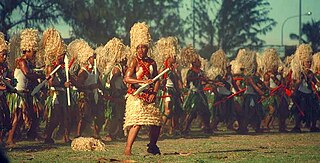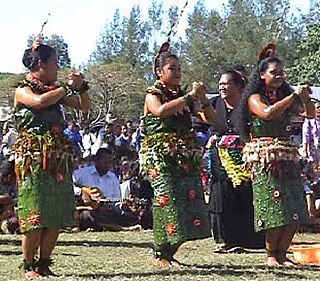
The history of Tonga is recorded since the century after 900 BC, when seafarers associated with the Lapita diaspora first settled the islands which now make up the Kingdom of Tonga. Along with Fiji and Samoa, the area served as a gateway into the rest of the Pacific region known as Polynesia. Ancient Tongan mythologies recorded by early European explorers report the islands of 'Ata and Tongatapu as the first islands having been hauled to the surface from the deep ocean by Maui.
In the mythology of Tonga, Havea Hikuleʻo is the god of the world, Pulotu. The islands of Kao, Tofua, Hunga Haʻapai, Hunga Tonga, Late and Fonualei came from stones thrown down from the skies by Hikuleʻo. They are all volcanic islands. The other, (coral) islands were fished up by his brother or cousin Maui.

Tāufaʻāhau Tupou IV, son of Queen Sālote Tupou III and her consort Prince Viliami Tungī Mailefihi, was the king of Tonga from the death of his mother in 1965 until his own death in 2006.

Haʻamonga ʻa Maui is a stone trilithon located in Tonga, on the north of the island of Tongatapu, near the village of Niutōua, in Heketā.

The Tongan archipelago has been inhabited for perhaps 3000 years, since settlement in late Lapita times. The culture of its inhabitants has surely changed greatly over this long time period. Before the arrival of European explorers in the late 17th and early 18th centuries, the Tongans were in frequent contact with their nearest Oceanic neighbors, Fiji and Samoa. In the 19th century, with the arrival of Western traders and missionaries, Tongan culture changed dramatically. Some old beliefs and habits were thrown away and others adopted. Some accommodations made in the 19th century and early 20th century are now being challenged by changing Western civilization. Hence Tongan culture is far from a unified or monolithic affair, and Tongans themselves may differ strongly as to what it is "Tongan" to do, or not do.

The Tuʻi Tonga Empire, or Tongan Empire, are descriptions sometimes given to Tongan expansionism and projected hegemony in Oceania which began around 950 CE, reaching its peak during the period 1200–1500.
The Tuʻi Tonga is a line of Tongan kings, which originated in the 10th century with the mythical ʻAhoʻeitu; withdrew from political power in the 15th century by yielding to the Tuʻi Haʻatakalaua; and died out with Laufilitonga in 1865. Today its descendants still live forth in the chiefly line of Kalaniuvalu.

The tauʻolunga is a traditional Tongan dance. The type of dance is comparable with (some) Hawaiʻian hula or the Tahitian ʻaparima.
Momo(meaning: crumb) was the 10th Tuʻi Tonga, a dynasty of mighty kings in Tonga, and lived somewhere in the 11th, maybe 12th century CE. He was named after one of the original gods of Tonga, a trio known as Kohai, Koau, mo Momo. It was under his reign that the Tuʻi Tonga maritime empire started to blossom.

Tafahi is a small island in the north of the Tonga archipelago, in fact closer to Savaiʻi (Samoa) than the main islands of Tonga. It is only 9 km (5.6 mi) north-northeast away from Niuatoputapu, and fishermen commute in small outboard motorboats almost daily between the two.
Tangaloa was an important family of gods in Tongan mythology. The first Tangaloa was the cousin of Havea Hikuleʻo and Maui, or in some sources the brother or son or father of them. He was Tangaloa ʻEiki, and was assigned by his father, Taufulifonua, the realm of the sky to rule.
Tuʻi-tā-tui(translation: The king who strikes the knee) was the 11th king of the Tuʻi Tonga, a dynasty in Tonga, who supposedly lived during the 12th century AD. Most of what is known about him is through Tongan myths and tales.
Aleamotuʻa was the 18th Tu'i Kanokupolu of Tonga, the third lineage of Tongan Kings with the political and military power who ruled in support of the Tu'i Tonga.
The People of Paradise is a six-part documentary film series produced and presented by David Attenborough. The series exhibits the people and geography of Oceania; particularly, of Fiji and Tonga. BBC Television Service transmitted The People of Paradise in 1960.
Ama is a title originating c. 1400 AD, and bestowed upon the paramount chief and commander in war of the district of Safata, situated south of the island of Upolu, within the country of Samoa. It is a hereditary title. The title originated from Lotofaga, a village within the Safata district. Lotofaga is a village that sits in the middle of the Safata Bay. The village has been described as the following: 'Here the surf is sometimes so wild that one cannot sleep because of the roar; therefore it is called Galutatu'. It is also known as Le-Faga-o-Alii, translated in Samoan as 'The Bay of Chiefs'. This is in reference to the Ama that resides there. Lotofaga is traditionally known to be a village of refuge for those in need as well as a place to observe and learn of Samoan chief customs and etiquette.

Coronations in Oceania are, or were, held in the following countries:













